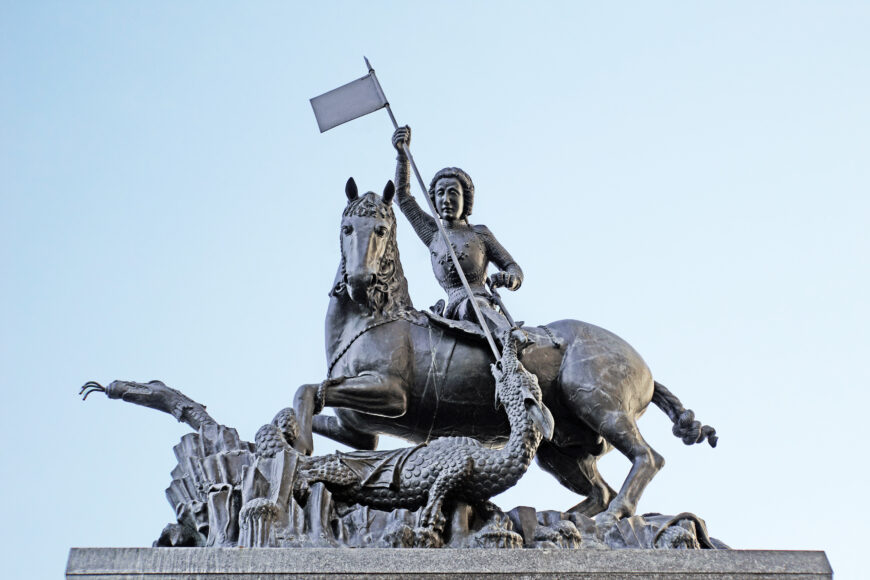
Martin and George of Kolozsvár, Saint George (replica), 1373, bronze, 196 cm high (Prague Castle; photo: Dennis Jarvis, CC BY-SA 2.0)
One of the most significant bronze statues of the late Middle Ages features Saint George and the dragon. The lively and dynamic composition is about three-quarters life-size (almost 2 meters high). The horse rides toward the left on a rocky terrain inhabited by snakes and lizards, but rears up and turns his head back toward the dragon. Saint George holds his spear in his right hand and thrusts it diagonally in front of the horse, hitting the throat of the dragon. In his left hand, he once held a shield with a cross and an inscription that dated the work to 1373 and named its makers.
Subject and iconography: Saint George and the dragon
According to legend, Saint George was a Christian Roman knight in the late 3rd century who had arrived in the town of Silena, Libya. The town was terrorized by a dragon living in a nearby swamp, who first demanded the sacrifice of sheep and then people to spare the town. When George arrived, it happened to be the turn of the daughter of the King to be devoured by the dragon. George defeated the dragon—killing it with his lance. He attributed his victory to the help of Christ, thereby converting the entire town to Christianity.
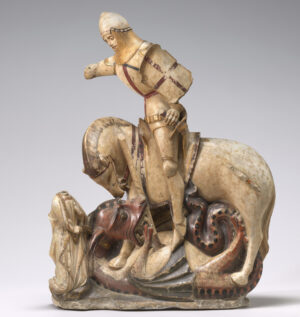
Saint George and the Dragon, c. 1370–1420, painted and gilded alabaster, 81.5 x 60.5 x 20.5 cm (National Gallery of Art, Washington D.C.)
As this was the time of great Christian persecution, George eventually suffered martyrdom by the orders of the Roman prefect Dacian. He was then canonized (made a saint) and revered as a martyr. Later, he became immensely popular due to his victory over the dragon. His cult grew first in the Byzantine Empire and later spread west (primarily in Rome and later in England). He was one of the most popular saints in Eastern and Central Europe as well.
Saint George was a patron saint of knights, especially of Crusaders. The most popular version of his legend was included in the Golden Legend compiled by Jacobus de Voragine around 1260. King Charles I of Hungary established a knightly military order in his honor in 1326.
In the Byzantine Empire, Saint George was usually depicted in the company of other military saints such as Saint Demetrius and Saint Theodore. Cycles showing his life and martyrdom can be found in manuscripts and wall-paintings, but by far the most common depiction of Saint George was his fight with the dragon. In a moment frozen in time, Saint George defeats the beast and saves the princess, setting an example to all Christian knights.
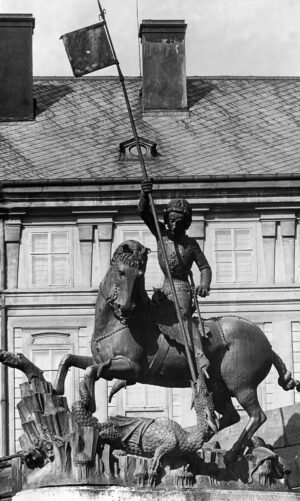
Martin and George of Kolozsvár, Saint George, photographed before 1927 on its Baroque pedestal, 1373, bronze, 196 cm high (Prague Castle; photo: Bildarchiv Foto Marburg)
The makers of the statue
Saint George’s now-missing shield, which was stolen in 1795, carried an inscription in Latin that was copied several times before it went missing. It offered the name of the creators of the statue along with the year of completion: “In 1373, this image was made by Martin and Georg of Clussenberch.” The unfamiliar name of the town can be read as Klausenburg, the German name of the Transylvanian town of Kolozsvár, at that time part of the Kingdom of Hungary (now Cluj-Napoca in Romania). This was the key to the identification of the masters, who are well-known from other inscriptions of famous statues that once stood in front of the cathedral of Várad (these were destroyed when the Ottomans occupied the town in 1660, but their inscriptions had been recorded earlier).
These sources offer some insight into the artists Martin and George: we learn that they their father was a painter (Nicholas of Kolozsvár). In the 1360s, the brothers came to Várad and set up a bronze foundry in the town, which was able to produce unparalleled monumental statues.
Monumental bronze in the late Middle Ages
Although the statues at Várad do not survive, the statue of Saint George in Prague attests to the skill of the brothers Martin and George. It was made using the lost wax technique, which requires a complex workshop and tremendous skill. According to several historical observations, the statue of Saint George was also at least partially gilded, which would have further enhanced its already splendid appearance.
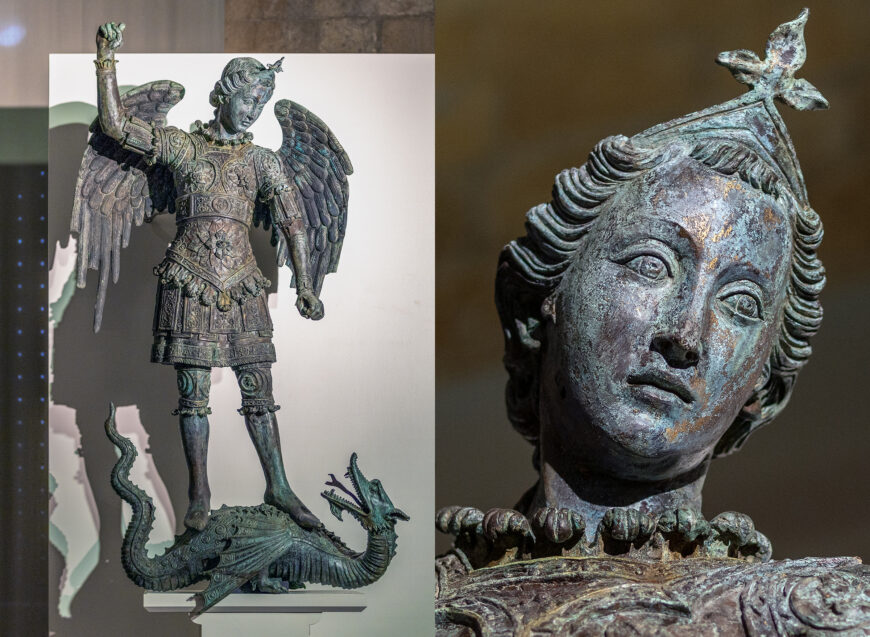
Matteo di Ugolino da Bologna, Saint Michael the Archangel (with detail of face), 1356, bronze (Orvieto Cathedral; photos: Steven Zucker, CC BY-NC-SA 2.0)
The process of making a large-scale bronze statue can take years. The brothers may have become familiar with bronze casting in Hungary, where bells were made in this technique. Martin and Georg of Kolozsvár were also likely familiar with sculptural work in Orvieto, Italy. The head of their Saint George bears a close resemblance to the bronze figure of Saint Michael cast by Matteo di Ugolino da Bologna in 1356 and placed on top of the gable above the right portal of the Orvieto Cathedral.
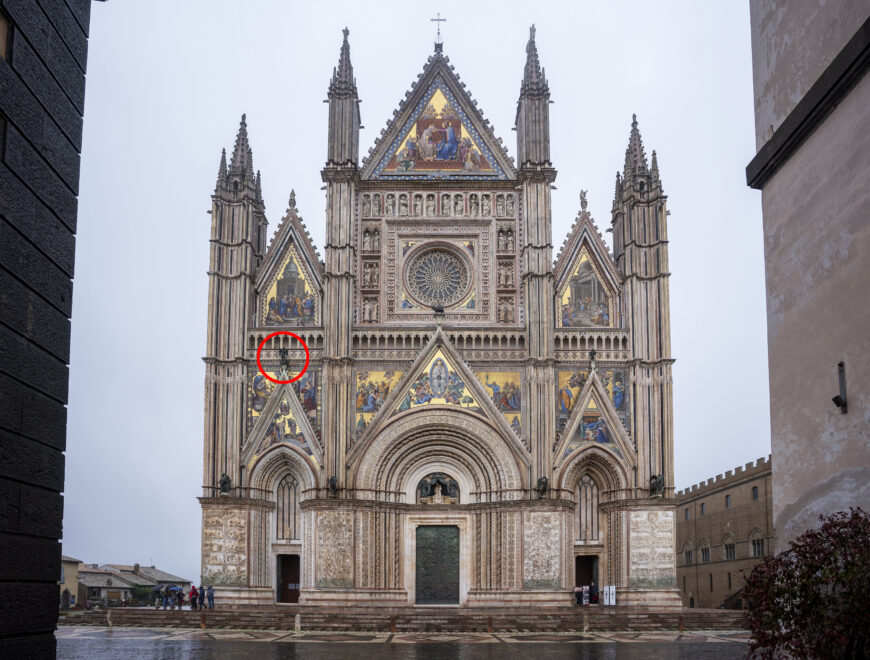
Orvieto Cathedral façade with Saint Michael circled, Orvieto, Italy, begun 1290 (photo: Steven Zucker, CC BY-NC-SA 2.0)
It is very likely that the young brothers from Hungary spent some time in the cathedral workshop of Orvieto, learning the technique of casting large-scale figural statuary and getting to know the Italian art of the mid-14th century. The composition of their Saint George figure—the best analogs of which can be found in Italian book illuminations of that period—also betrays their Italian training. If they were born in the 1330s, they likely spent their early twenties in Orvieto around the 1350s, after which they returned to Hungary to start work as independent masters.
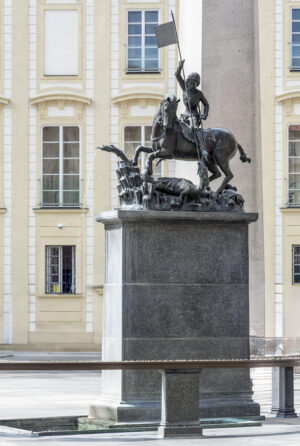
Martin and George of Kolozsvár, Saint George (replica), 1373, bronze, 196 cm high (Prague Castle; photo: Jacek Halicki, CC BY-SA 4.0)
The commissioner of the Prague statue
The Prague statue of Saint George was first mentioned in 1541, when it suffered some damage during the catastrophic fire that destroyed much of Prague castle. At that time, the right arm of Saint George broke off. In 1562, we read that it served as a fountain and that it was broken again during the coronation of Maximilian II. Spectators climbed up on the statue, which fell as the legs of the horse broke and the head of the horse smashed. Repairs were carried out in the following years. The statue was later placed on top of a Baroque fountain and was moved a few times within Prague castle.
Its present arrangement dates to 1927 when the Slovenian architect Jože Plečnik created a new pedestal for it. The original statue was restored during the German occupation of Czechoslovakia, in 1941–42. At that time, the statue was moved into a museum and replaced with a copy. Since April 2004, the original statue has been on display in the permanent exhibition dedicated to the history of Prague Castle. Full-scale copies of the statue can also be found in many museums and on public display, including at Cluj-Napoca, the hometown of the masters.
Although first documented in 1541, most scholars believe that the statue has been in Prague since 1373. It is most likely that work was carried out at Várad and the statue was transported to Prague.
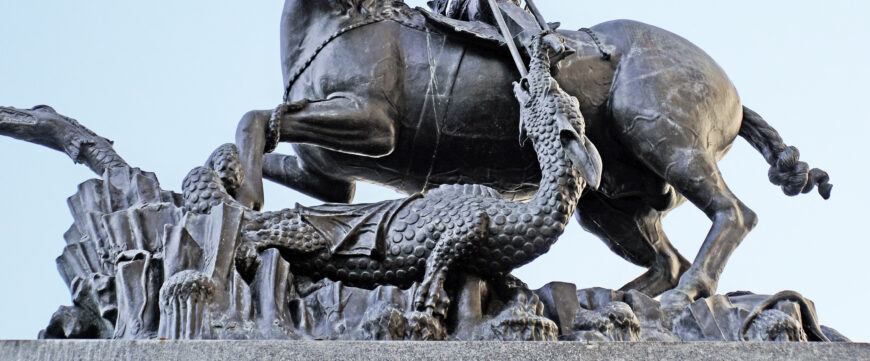
Dragon and swampy environment at the base of the statue (detail), Martin and George of Kolozsvár, Saint George (replica), 1373, bronze, 196 cm high (Prague Castle; photo: Dennis Jarvis, CC BY-SA 2.0)
The original function and setup of the statue is unclear: some argue that the swampy environment, alluded to in the details of the base, indicates that perhaps it was always intended to be a fountain statue. Others presume a more religious context for the work, in which case it was probably placed under a canopy, possibly inside a church.
Regardless of its history, the statue of Saint George slaying the dragon is a marvelous survival and a unique testament to the refinement of East-Central European Gothic art and of the very strong reception of Italian art in the Kingdom of Hungary during the Angevin period. Along with the statue of Saint Ladislas, it is the first monumental bronze equestrian statue since Antiquity, pre-dating by several decades Donatello’s Gattamelata and the equestrian statue of Niccolo d’Este in Ferrara.

